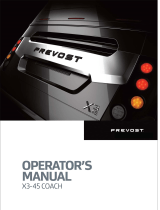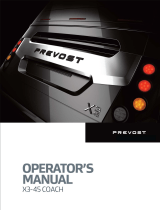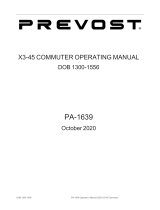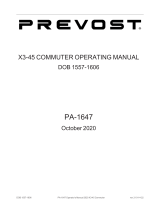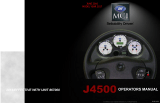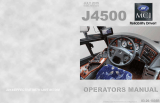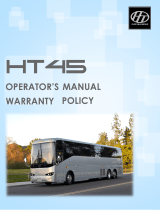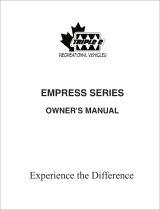Page is loading ...

OPERATOR’S
MANUAL
X3-45 COACH


COACH MANUFACTURER
OPERATOR’S MANUAL
X3-45 COACH
PA1618 rev.3
December 2017

PA1618
Featuring:
Cooling system electric fans.
New electrical architecture
GHG 2017 emission control
First edition: July 2016, Model-year 2016 preliminary vehicle G-6092
REV EFFECTIVE DESCRIPTION DATE
0
1 First Release
H-6180
Telematics note added and general revision July 2016
Dec 2016
2 H-6180 Starting and Stopping : Updated Rear Start panel June 2017
3 J-6281 / J-7482 ELD interface connector added Dec. 2017

Foreword
i
FOREWORD
This Operator's Manual for the PREVOST X3-
45 coach has been prepared to thoroughly
acquaint you, the driver, with the equipment and
features of the coach in order for you to fully
appreciate and safely enjoy this vehicle. Prevost
is committed to the continuous improvement of
coach quality, reliability, durability and safety.
With innovative features, the X3 series coach was
designed with passenger and driver safety and
comfort in mind.
This manual contains information available at the
time of publication. Because standard and
optional equipment is covered in this manual,
some of the optional equipment described may
not apply to your coach. If in doubt, refer to the
technical documentation package provided with
the coach.
Driver's controls and instruments incorporate
advanced technology for enhanced driving ease
and security. This manual describes the main
features, instruments and controls, and servicing
requirements for both standard and optional
equipment. Read this manual carefully to take
advantage of the coach's advanced features and
to ensure optimum safety and passenger comfort.
Keep this manual in the coach at all times. Make
sure this manual is kept with the coach when
ownership is transferred. Please use the
appropriate card at the end of this manual to
promptly notify Prevost of any change of address
or transfer of ownership. This will ensure we
provide fast and reliable coach service to all
coach operators.
Note: Illustrations in this manual are used for
reference only and may differ slightly from the
actual vehicle; however, key components
addressed in the manual are represented as
accurately as possible.
DANGER, WARNING, CAUTION and
NOTE
. are
used throughout this manual to emphasize
important points when necessary:
DANGER
Directs th
e operator’s attention to unsafe
practices which could result in serious
personal injury or death.
WARNING
Directs the operator’s attention to unsafe
practices which could result in serious
personal injury or severe damage to the
vehicle.
CAUTION
Directs the operator’s attention to unsafe
practices where personal injury is not likely
but damage to vehicle compo
nents could
occur.
NOTE
Indicates supplementary information essential
to the proper operation of the vehicle.
The service life of the coach depends on the kind
of attention it receives. Pay close attention to the
DANGER, WARNING, CAUTION and
NOTE
.
Read the various notices and instructions posted
throughout the coach and attached to equipment.
Since continuous improvement is a primary focus at Prevost,
we reserve the right to make changes anytime, without notice,
and without incurring any obligation.
Before reproducing or copying this manual, in whole or in
part, written consent must be obtained from Prevost.

Foreword
ii
CRITICAL EMISSION-RELATED MAINTENANCE
Source of parts and repair:
A repair shop or person of the owner’s choosing must maintain, replace, or repair emission control
devices and systems per manufacturer's recommendations.
Replacement of tires that are GHG certified:
The original equipment tires installed on this vehicle at the factory were certified to the U.S. EPA
Greenhouse Gas (GHG) and National Highway Traffic Safety Administration (NHTSA) Fuel
Efficiency regulations. Replacement of these tires should
be with
a tire of equal or lower rolling
resistance levels (TRRL or Crr). Please consult your tire supplier(s) for appropriate replacement tires.
Maintaining a GHG certified tire:
In order to maintain the certified rolling resistance of the tires which optimize fuel economy, the
maintenance procedures provide by the tire manufacturer must be followed.
EVENT DATA RECORDING DEVICES
This PREVOST vehicle is equipped with a device generally referred to as an "event data recorder" or
"EDR." Please note that while the term "event data recorder" is typically used throughout the motor
vehicle industry, not every EDR is the same; i.e., they do not all record the same data elements.
The EDR on this PREVOST vehicle records vehicle speed, engine RPM, time and date, plus a variety of
pedal and switch positions, both before and after an "event." Sudden vehicle deceleration or the
occurrence of certain other vehicle operational characteristics will define (trigger) an "event."
For any questions about this vehicle EDR device, contact a PREVOST Service Center or a regional
service manager.

Foreword
iii
TELEMATICS DEVICE
Your vehicle is equipped with one or more recording devices (“Telematics Device”), associated with
Prevost’s Connected Vehicle Services (the “Telematics Services”). These services, which are described
in greater detail at www.prevostcar.com (the “Website”), allow you to manage vehicle maintenance and
repair in a cost-effective manner by providing: proactive diagnostic and repair planning assistance with
detailed analysis of diagnostic trouble codes; streamlined service procedures with parts-on-hand
confirmation before a vehicle arrives for service; and live repair and customer communication. The
service eliminates or reduces diagnostics time, enhances repair efficiency, expedites decision process,
improves communications and maximizes uptime. To access the Telematics Services, you must enter
into a Telematics Subscription Agreement with Prevost, via the sales agreement pertaining to your
vehicle.
The Telematics Device collects stores and/or transmits information about your vehicle. Such information
may include direction and rate of speed, fuel consumption, engine performance, gearing, rpm, altitude,
geo-location (including a history of where the vehicle travels), safety information related to the use and
operation of the vehicle, vehicle performance, diagnostic data and error codes. The Telematics Device
has the capacity to store historical data about the use and performance of your vehicle. The Telematics
Device has the ability to transmit information to a central communications system. The information
contained in your Telematics Device may be periodically transmitted to or accessed by Prevost and
others authorized by Prevost, along with your vehicle’s VIN number or other identifying information.
Prevost does not collect any driver information. Prevost retains and uses this information to understand
the operational use of your vehicle, to remotely tune your vehicle, and to help facilitate maintenance and
vehicle improvements. To the extent allowed by law, Prevost reserves the right to access, use and control
this information.
Declining to enter into a Telematics Subscription Agreement with Prevost, or canceling a Telematics
Subscription Agreement, will not end the transmission of data from your Telematics Device or the
collection of information by Prevost. Prevost may access Telematics Data, to the extent it is available, and
use it in connection with providing services and vehicle improvements to you and your vehicle. Prevost
will regularly purge from its systems all data collected from your Telematics Device, at time intervals
determined by Prevost at its sole discretion.
ELECTRONIC LOGGING DEVICE (ELD)
This vehicle is equipped with a dedicated ELD interface connector located under the lower left part of the
dashboard. This SAE J1939 9 PIN connector is compatible with most FMCSA approved ELD and will
ensure that the ELD will not interfere with the vehicle communication, diagnostic and/or driving systems.
Please take note that the OBD connector is only intended as a diagnostic equipment connection.
Installing an aftermarket plug-in device that uses the OBD port may cause interference and/or damage to
the vehicle systems, potentially affecting safe operation.
Both connectors (OBD and ELD) are clearly identified under the dash by stickers. The OBD port must
remain unconnected at all times except during vehicle maintenance (using Prevost approved
diagnostic equipment only).
Connecting aftermarket equipment to the OBD connector may lead to:
- Incorrect emission monitoring and failure to meet the requirements of emission tests.
- Erratic behaviour of one or more of the vehicle safety devices/driving aids, increasing the risk of
accidents.
- False code readings and inconsistency during vehicle diagnostic procedures, increasing vehicle
down time.
- Unreliable ELD connection/recording and potential violations with the federal ELD regulations*.
* For more information regarding Federal ELD requirements, consult the FMSCA


Table of Contents
iv
SAFETY PRECAUTIONS ............................................................................................. 1-1
COACH EXTERIOR ...................................................................................................... 2-1
COACH INTERIOR ...................................................................................................... 3-1
CONTROLS AND INSTRUMENTS .............................................................................. 4-1
OTHER FEATURES ..................................................................................................... 5-1
STARTING AND STOPPING PROCEDURE ................................................................ 6-1
SAFETY FEATURES AND EQUIPMENT ..................................................................... 7-1
CARE AND MAINTENANCE ........................................................................................ 8-1
TECHNICAL INFORMATION ....................................................................................... 9-1
ABBREVIATIONS
APPENDIX A – SERVICE LITERATURE
APPENDIX B – TROUBLESHOOTING GUIDE FOR MULTIPLEX VEHICLES
APPENDIX C – ALLISON DIAGNOSTIC TROUBLESHOOTING CODES
APPENDIX D – SPHEROS PREHEATER FLASH CODES
APPENDIX E – TPMS TROUBLESHOOTING GUIDE


Safety Precautions
1-1
SAFE OPERATING PRACTICES ................................................................................................................ 2
DEFENSIVE DRIVING PRACTICES ............................................................................................................ 2
OTHER PRECAUTIONS .............................................................................................................................. 3
TELEMATICS DEVICE ................................................................................................................................. 4

Safety Precautions
1-2
SAFE OPERATING PRACTICES
To ensure safe and reliable operation, heed the
following safety precautions.
• Operation and maintenance of the vehicle
must be performed only by qualified
personnel.
• Before driving, conduct a walk around
inspection and check that all baggage
compartment doors and equipment access
doors are securely shut.
• Make sure good visibility is maintained at all
times. Keep windshields clean and free of
obstructions.
• Adjust the driver's seat so that all controls
can be reached easily.
• Always wear your safety belt when driving.
• Check the instrument panel frequently. Do
not operate the vehicle when dials or
indicators do not indicate normal operating
conditions.
• Always pay attention to pedestrians passing
in front and behind the vehicle. Always yield
to pedestrians at pedestrian walkways.
• Do not drive over obstacles on the road.
Empty boxes, piles of leaves, and snowdrifts
could conceal hidden dangers that could
damage the vehicle suspension and
underbody.
• When turning or changing lanes, signal your
intention well in advance.
• When approaching to make a right turn,
reduce the space between the vehicle and
the curb to make sure another vehicle
cannot pass on the right. Since the vehicle
makes wide turns, allow enough space to
make safe turns.
• Switch from high beams to low beams when
meeting or following other vehicles within
500 feet (150 meters).
• Never leave the vehicle unattended with the
engine running or with the key in the ignition.
Turn off the engine, remove keys and apply
the parking brake before leaving the vehicle.
• Shut-off the engine before refueling, adding
oil, performing maintenance or servicing
tasks, unless stated otherwise.
• Fuel is highly flammable and explosive. Do
not smoke when refueling. Keep away from
open flames or sparks.
• Do not run the engine or HVAC system with
access doors left open. Close compartment
doors before operating any equipment.
• Do not remove the surge tank filler cap or
the cooling system pressure cap when the
engine is hot. Let the engine cool down
before removing filler caps.
• Do not attempt to push or pull-start the
vehicle.
• The service life of the vehicle depends on
the kind of maintenance it receives. Always
record any problems and report them
immediately to maintenance personnel.
DEFENSIVE DRIVING PRACTICES
• For city driving, allow a four to six second
travel interval between your vehicle and the
vehicle ahead. Increase this travel interval to
six to eight seconds for highway driving.
Increase time interval for driving at night or
in foul weather.
• Be prepared to stop when approaching an
intersection. The stopping distance of the
vehicle increases with the weight and speed.
• Establish eye-to-eye contact with other
drivers and with pedestrians. Use, high
beam and low beam headlights, turn signals
and horn as needed.
• On highway, don't stare at the road ahead.
Keep your eyes moving. Check mirrors and
dashboard instruments frequently.
• To keep the vehicle from drifting across
lanes during highway driving, always look
over the horizon on the road ahead.
• Adjust your speed to road conditions, traffic
and visibility. Never exceed the posted
speed limits.
• If another vehicle is following close behind,
reduce your speed to let the vehicle pass.
• For additional information about safe
operation and defensive driving practices,
contact the local department of motor
vehicles authority.

Safety Precautions 1-3
OTHER PRECAUTIONS
WARNING
This vehicle is not designed to carry
standing passengers.
WARNING
CALIFORNIA PROPOSITION 65:
Diesel engine exhaust and some of
its
constituents are known to the State of
California to cause cancer, birth defects
and
other reproductive harm.
Battery posts, terminals and other related
accessories contain lead and lead
compounds, chemical known to the State
of California to cause cancer and other
reproductive harm.
Batteries also contain other chemicals
known to the State of California to cause
cancer.
Wash hands after handling.
DANGER
Make sure that electrical current or air
pressure is removed before performing any
work. A part may be energized even if the
ignition switch is OFF. A part may be under
pressure even if all tanks are empty.
Before performing any work on the vehicle,
refer to wiring diagrams and/or air
schematics to thoroughly understand the
system.
NOTE
When the ignition switch is set to the OFF
position, the electrical components are not
energized except for the MCM (Master
Chassis Module), the battery equalizer, the
preheater system and
some electronic
modules; which are energized during 15
minutes after the ignition has been set to the
OFF position. Prior to working on one of
these electrical components, set the battery
master switch in the main power
compartment to the OFF position. If the
vehicle will not be operated for a long period
(more than 2 weeks), it is recommended, in
order to prevent the batteries from
discharging, to trip the main circuit breakers
located in the main power compartment to
stop the small current drawn by the radio
preset station memory, the MCM memory
and the instrument cluster clock. Note that
the radio station presets will be erased,
same thing for the diagnostic codes history
and the instrument cluster clock will have to
be reset.
CAUTION
PRECAUTIONS ARE TO BE OBSERVED
BEFORE WELDING TO MINIMIZE THE
RISK OF MAJOR AND COSTLY
DAMAGES CAUSED TO THE VEHICLE
ELECTRONIC COMPONENTS!
1. Set the battery master switch to “OFF”
position.
2. Trip circuit breaker CB2 and CB6.
3. Disconnect electronic ground terminal
from the ground junction block located
in the battery compartment.
4. Make sure to clamp the welding ground
return as close as possible to the
welding point and make a good electric
contact to the chassis.
Detailed instructions are provided in
section 00-GENERAL of your vehicle
maintenance manual.


Coach Exterior
2-1
ENGINE COMPARTMENT COMPONENTS ........................................................................................................... 3
ENGINE COMPARTMENT CURB-SIDE DOOR ....................................................................................................... 4
ENGINE COMPARTMENT REAR DOOR ............................................................................................................... 4
EXHAUST AFTERTREATMENT SYSTEM ACCESS DOOR ........................................................................................ 5
ENGINE RADIATOR DOOR ................................................................................................................................. 6
SCR ACCESS DOOR ............................................................................................................................................ 6
CONDENSER COMPARTMENT (A/C) .................................................................................................................. 7
EVAPORATOR COMPARTMENT ......................................................................................................................... 8
COOLANT HEATER ............................................................................................................................................. 8
FRONT ELECTRICAL AND SERVICE COMPARTMENT ........................................................................................... 8
BAGGAGE COMPARTMENTS ............................................................................................................................. 9
SPARE WHEEL COMPARTMENT ......................................................................................................................... 10
FUEL AND DIESEL EXHAUST FLUID (DEF) FILLER DOOR ....................................................................................... 10
ENTRANCE DOOR .............................................................................................................................................. 11
DOOR OPERATION LOGIC ........................................................................................................................... 12
EMERGENCY ENTRANCE DOOR OPENING .................................................................................................. 12
WHEELCHAIR LIFT ACCESS DOORS ..................................................................................................................... 12
REAR VIEW MIRRORS ........................................................................................................................................ 12
BACK-UP CAMERA............................................................................................................................................. 13
120 VOLT CONNECTORS .................................................................................................................................... 13
HUBODOMETER ................................................................................................................................................ 13
TRAILER HITCH .................................................................................................................................................. 13

Coach Exterior
2-2
X3-45 EXTERIOR VIEW (TYPICAL) 18707
1. Engine air filter intake grill
2. Engine compartment curb-side door
3. Hinged rear fender
4. Baggage compartment
5. Fuel & DEF filler door
6. Condenser compartment
7. Entrance door control switch
8. Entrance door
9. Engine compartment rear door
10. Rear-view mirrors
11. Spare wheel compartment
12. Front electrical and service compartment
13. Driver’s power window
14. Evaporator compartment and coolant heater compartment
15. Radiator door
16. Catalytic converter access door
17. Exhaust aftertreatment system access door

Coach Exterior
2-3
ENGINE COMPARTMENT COMPONENTS
ENGINE COMPARTMENT FEATURING VOLVO D13 ENGINE
1. Diesel Oxidation Catalyst (DOC) & Diesel Particulate Filter (DPF) Assembly;
2. Transmission fluid dipstick (if equipped with Allison transmission);
3. Coolant fluid surge tank filler cap;
4. Coolant fluid surge tank sight glass;
5. Power steering fluid reservoir;
6. Engine oil dipstick;
7. Air filter;
8. Air filter restriction indicator;
9. Alternators, Road side
10. Alternator, Curb side;
11. Engine oil filler tube;
12. Central A/C compressor;
13. Compressor belt tensioner;
14. Charge air cooler;
15. Radiator;

Coach Exterior
2-4
ENGINE COMPARTMENT CURB-SIDE
DOOR
The engine compartment curb-side door
provides access to the following (if equipped):
• Engine compartment rear door release
handle;
• Booster terminals;
• Rear electrical panel;
• Rear junction panel;
• Battery compartment;
• Fuel filter/water separator (Optional);
• Air circuit fill valve and drain cock;
• Sump tank access cap;
• 110 - 120 volt connector;
• Lavatory maintenance valve and connectors;
• Fresh water reservoir fill connector;
ENGINE COMPARTMENT CURB-SIDE DOOR
This door can be locked or unlocked using the
exterior compartment key or, if so equipped, by
the central door locking system. To open, pull
towards the front on the rod located in the recess
to the right of the door.
NOTE
This compartment can be locked/unlocked
using the central locking system by pressing
the switch located on the L.H. side dashboard
panel.
ENGINE COMPARTMENT R.H. SIDE 18607_1
A telltale light illuminates when one or more
compartments are unlocked.
ENGINE COMPARTMENT REAR
DOOR
To open the engine compartment rear door,
open the engine compartment curb side door
and pull the yellow handle located on the rear
door, grab the side of the door in the middle, pull
and lift the door.
OPENING ENGINE COMPARTMENT REAR DOOR 18608
WARNING
Unless otherwise stated, do not run the engine
when the engine compartment is open.

Coach Exterior
2-5
The door swings out to provide access to the
following:
• Engine;
• Alternator(s);
• Compressor(s);
• Belt tension control valve (refer to chapter,
Care and Maintenance);
• Engine starting selector (refer to chapter,
Starting and Stopping Procedures);
• Coolant line shutoff valves;
• Certification plates;
• Engine coolant surge tank and filler cap;
• Air filter restriction indicator;
• Engine oil dipstick;
• Power steering fluid reserve tank;
• Allison automatic transmission fluid dipstick;
NOTE
The engine compartment lights will turn
on automatically when the engine door is
opened.
A catch engages to maintain the door in the full
open position. To close the door, slightly lift up
the door and release the catch before firmly
shutting down the door.
REAR DOOR SAFETY CATCH
WARNING
Unless otherwise specified, do not run engine
when the engine compartment r
ear door is
open. Close the engine compartment rear door
before starting the engine.
EXHAUST AFTERTREATMENT
SYSTEM ACCESS DOOR
The engine door must be
open before opening the
exhaust aftertreatment
system access door. To
open the access door,
lower the
latch release
lever, using
a flat tip
screwdriver.
AFTERTREATMENT ACCESS DOOR LATCH
To close the door, lower the door and push
against the release lever spring to latch the door
shut.

Coach Exterior
2-6
ENGINE RADIATOR DOOR
The engine radiator door gives access to the
radiator electrical fans and power distribution
box.
RADIATOR DOOR
Open the engine compartment rear door to
access the engine radiator door release handle
Radiator door release handle is located inside
the left pillar (Arrow).
RADIATOR DOOR HANDLE LOCATION
Pull handle towards you to release radiator door.
RADIATOR DOOR RELEASE HANDLE
RADIATOR DOOR OPENED
WARNING
WHEN THE ENGINE IS RUNNING…
Cooling fans may activate at any moment.
Keep hands away from cooling fans or keep
the radiator door closed.
WARNING
Cooling fans may be running when the
engine is shut down
in the following
conditions:
•
If a High Exhaust Temperature
condition exists (e.g. following
regeneration). The CAC fans will keep
running for a maximum of 15 minutes.
• During the electric
Motor Test
Sequence, the cooling fans will start
running briefly.
SCR ACCESS DOOR
To gain access to the SCR, open the radiator
door first. At the top of the radiator compartment,
pull the catch connecting rod to unlock the
catalytic converter access door and lift the door
open.
Hold the door open by inserting the support rod
free end into the receptacle located on the left
side of the DPF.
/
